Telangana TSBIE TS Inter 1st Year Botany Study Material 9th Lesson The Unit of Life Textbook Questions and Answers.
TS Inter 1st Year Botany Study Material 9th Lesson The Unit of Life
Very Short Answer Type Questions
Question 1.
What is the significance of vacuole in a plant cell? [May ’17]
Answer:
- In plant cell, vacuole plays an important role in osmoregulation.
- In some plant cells vacuolar sap contains pigments like anthocyanin, which impart colour to the plant parts.
Question 2.
What does ‘S’ refer in a 70S & and 80S ribosome? [Mar. ’17 – T.S.]
Answer:
- ‘S’ refers sedimentation coefficient (expressed in Svedburg unit)
- It is indirectly a measure of density and size.
Question 3.
Mention a single membrane bound organelle which is rich in hydrolytic enzymes. [Mar. ’15 – T.S.]
Answer:
- Lysosomes.
- They contain hydrolases capable of digesting carbohydrates, proteins, lipids and nucleic acids.
Question 4.
What are gas vacuoles? State their functions.
Answer:
Gas vacuoles are inclusion bodies in cytoplasm of Blue green, purple and green photosynthetic bacteria. They are filled with air and help the bacteria to float on the surface of water.
Question 5.
What is the function of a polysome?
Answer:
- In prokaryotes, several ribosomes may attach to single m RNA and form a chain called polysome.
- The ribosomes of a polysome translate the m RNA into proteins.
Question 6.
What is the feature of a metacentric chromosome? [Mar. – 2018]
Answer:
- The metacentric chromosome has middle centromere.
- Hence this chromosome consists of two equal arms.
![]()
Question 7.
What is referred to as Satellite Chromosome? [Mar. ’20, ’17]
Answer:
- Satellite Chromosome: Chromosome with non-staining secondary constriction at a constant location.
- This gives the appearance of a small fragment called the satellite.
Question 8.
What are microbodies? What do they contain? [May ’14]
Answer:
- Peroxysomes and glyoxysomes are called microbodies.
- Glyoxysomes contain the enzymes of glyoxylate cycle which convert stored lipid into carbohydrates. Peroxysomes contain enzymes which convert fatty acids into carbohydrates
Question 9.
What is middle lamella made of? What is its functional significance? [Mar. ’15 – A.P.]
Answer:
- Middle lamella is made of calcium pectate.
- It holds or glues the different neighbouring cells together.
Question 10.
What is osmosis?
Answer:
- Movement of water by diffusion across the membrane is called Osmosis.
- In this process, water moves from higher concentration to lower concentration across the plasma membrane.
Question 11.
Which part of the bacterial cell is targeted in gram staining?
Answer:
- Chemical composition of cell envelop.
- Bacteria that take up gram stain are called Gram positive and that do not are called Gram negative.
Question 12.
Which of the following is not correct? [Mar. ’13]
a) Robert Brown discovered the cell.
b) Schieiden and Schwann formulated the cell theory.
c) Virchow explained that cells are formed from pre-existing cells.
d) A unicellular organism carries out its life activities within a single cell,
Answer:
a) Robert Brown discovered the cell – not correct.
Question 13.
New cells generate from
a) bacterial fermentation
c) pre-existing cells
Answer:
c) Pre-existing cells
![]()
Question 14.
Match the following. [Mar. – 2019]
a) Cristae i) Flat membranous sacs in stroma
b) Cisternae ii) Infoldings in mitochondria
c) Thylakoids iii) Disc-shaped sacs in Golgi apparatus
Answer:
a) — ii b) — iii c) — i
Question 15.
Which of the following is correct?
a) Cells of all living organisms have a nucleus.
b) Both animal and plant cells have a well defined cell wall.
c) In prokaryotes, there are no membrane bound organelles.
d) Cells are formed de novo from abiotic materials.
Answer:
a) In prokaryotes, there are no membrane bound organelles – correct.
Short Answer Type Questions
Question 1.
Discuss briefly the role of nucleolus in the cells actively involved in protein synthesis.
Answer:
- A spherical body present in nuclear matrix, the nucleoplasm is called as , nucleolus (plu. Nucleoli). It is not a membrane bound structure.
- In some nucleus one or more nucleoli may be presents
- It is a site for active synthesis of ribosomal RNA.
- rRNA make cell organelles ribosomes, the sites of protein synthesis, several ribosomes may attach with a mRNA to form a chain, referred to be polyribosomes (polysome.) The ribosomes of a polysome translate the mRNA into proteins.
- Larger and more numerous nucleoli are present in cells actively carrying out protein synthesis.
Question 2.
Explain the association of carbohydrate to the plasma membrane and its significance.
Answer:
- The lipid component of the plasma membrane mainly cpnsists of phospho-glycerides.
- Biochemical investigations clearly revealed that the cell membranes also possess carbohydrates.
- Carbohydrates present outside the plasma membrane and are attached to extrinsic proteins, integral protein and also hydrophilic (polar) heads of the lipids. They may be glycoproteins or glycolipids.
Question 3.
Comment on the cartwheel structure of centriole.
Answer:
- Centrosome is an organelle usually containing two cylindrical structures called centrioles.
- They are surrounded by amorphous pericentriolar materials.
- Both the centrioles in a centrosome lie perpendicular to each other in which each has an organisation like the cartwheel.
- They are made up of nine evenly spaced peripheral fibrils of tubulin.
- Each of the peripheral fibril is a triplet. The adjacent triplets are also linked.
- The central part of the centriole is also proteinaceous and called the hub, which is connected with tubules of the peripheral triplets by radial spokes made of protein.
- The centrioles form the basal body of the cilia or flagella, and the spindle fibres that give rise to spindle apparatus during cell division in animal cells.
Question 4.
Briefly describe the cell theory,
Answer:
- Cell theory was proposed by M.J. Sehleiden, a German botanist and T. Schwann, a British zoologist.
- The cell theory states that
a) Cell is the structural unit of all organisms.
b) Cell is the functional unit of all organisms.
c) R.Virchow proposed that new cells arise from pre-existing cells (Omnis cellula- e-cellula) or from the parent cell.
Question 5.
Differentiate between Rough Endoplasmic Reticulum (RER) and Smooth Endoplasmic Reticulum (SER). [Mar. 17 -A.P.]
Answer:
| Rough Endoplasmic Reticulum (RER) | Smooth Endoplasmic Reticulum (SER) |
| 1. The endoplasmic reticulum bearing ribosomes on their surface is called rough endoplasmic reticulum (RER). | 1. The endoplasmic reticulum which does not bear ribosomes is called smooth endoplasmic reticulum (SER). |
| 2. RER is frequently observed in the cells actively involved in protein synthesis and secretion. | 2. SER is the major site for synthesis of lipid. In animal cells, lipid-like steroidal hormones are synthesized in SER. |
![]()
Question 6.
Give the biochemical composition of plasma membrane. How are lipid molecules arranged in the membrane?
Answer:
The biochemical composition of plasma membrane is lipids, proteins and carbohydrates. In the membrane lipids are arranged in bilayer. Within the membrane lipids are arranged with the polar (hydrophilic) head towards the outer side. This ensures that the non-polar tail of saturated hydrocarbons is protected from the aqueous environment.
Fluid Mosaic Model was proposed by Singer and Nicolson. It is most widely accepted model. They described the cell membrane as “Protein ice bergs in a sea of lipids”. According to this model lipids are quasi-fluid in nature. This enables lateral movement of proteins within the overall bilayer.
Question 7.
What are plasmids? Describe their role in bacteria.
Answer:
- Small circular DNA molecules found outside genomic DNA in many Bacteria are called plasmids.
- The plasmid DNA confers certain unique phenotypic characters such as resistance to antibiotics in bacteria.
- Plasmid DNA is also useful to monitor bacterial transformation with foreign DNA.
Question 8.
What are histones? What are their functions?
Answer:
- Basic proteins associated with DNA in eukaryotes are called Histones.
- A typical nucleosome contains 200 bt of DNA double helix wrapped (2 turns) around a core of histone octamer having 2 copies each of 4 types of histone proteins (H2A, H2B, H3and H4). HI histone molecule lies outside the nucleosome core and seals the 2 turns of DNA by binding at the point where DNA enters and leaves the core.
- The association between negatively charged DNA and positively charged histones allows for a meaningful DNA packaging inside the nucleus.
Question 9.
What is Cytoskeleton? What functions is it involved in?
Answer:
- An elaborate network of filamentous proteinaceous structures present in the cytoplasm is collectively referred to as cytoskeleton.
- Eukaryotic cells contain three major components of cytoskeleton – namely micro filaments, intermediate filaments and microtubules.
- The cytoskeleton in a cell is involved in many functions such as mechanical support, maintenance of cell shape, cell motility, intracelluar transport, signalling across the cell and karyokinesis (movement of chromosomes during cell division).
Question 10.
What is endomembrane system? What cell organelles are not included in it? Why?
Answer:
- Each of the membranous organelles is distinct in terms of its structure and function.
- Many of these membranous organelles are together considered as endomembrane system because their functions are co-ordinated.
- The endomembrane system includes endoplasmic reticulum (ER), golgi complex, lysosomes and vacuoles.
- Since the functions of mitochondria, chloroplast and peroxisomes are not co¬ordinated with the above components, these are not considered as part of the endomembrane system.
Question 11.
Distinguish between active transport and passive transport.
Answer:
The molecules that moves across the membrane without any requirement of energy is called passive transport. A few ions or molecules are transported across the membrane through its carrier proteins against their concentration gradient, i.e., from lower to the higher concentration. Such a transport is an energy-dependent process, in which ATP is utilised and it is called active transport. Eg : Na+/K+ pump.
Question 12.
What are mesosomes? What do they help in plasma?
Answer:
- Plasma membrane infoldings in some bacteria are called mesosomes.
- These special membranous extensions are in the form of vesicles, tubules and lamellae.
- Mesosomes help in cell wall formation, DNA replication and its distribution to daughter cells.
- They also help in respiration, secretion, processes, to increase the surface area of the plasma membrane (helps in absorption of nutrients) and enzymatic content.
![]()
Question 13.
What are nucleosomes? What are they made of? [Mar. – 2019, May 17 ; Mar. 14]
Answer:
Chromatin appears as beads on string. The beads are known as nucleosomes. Typical nucleosome contains 200 bp of DNA double helix wrapped (two turns) around a core of histone octamer having two copies of each of four types of histone proteins viz., H2A, H2B, H3 and H4.
Question 14.
How do neutral solutes move across the plasma membrane? Can the polar molecules also move across it in the same way? If not, then how are these transported across the membrane?
Answer:
- Neutral solutes move across the plasma membrane by means of diffusion along
the concentration gradient. It moves from higher to lower concentration. - No, the polar molecule cannot move across it in the same way.
- Polar molecules require a carrier protein of the membrane to facilitate their transport across the membrane.
- Some ions or molecules are transported across the membrane against their concentration gradient, which is an energy dependent process. It is called active transport. In active transport ATP is utilised.
Question 15.
Name two cell-organelles that are double membrane bound. What are the characteristics of these two organelles? State their functions and draw labelled diagrams of both. [Mar. ’14]
Answer:
Chloroplast is the cell organelle which contains chlorophyll pigment.
- Chloroplasts are double membrane bound structure.
- If the two membrane, the inner membrane is relatively less permeable.
- The inner space of chloroplast is filled with a colourless matrix called stroma.
- Flattened sacs called thylakoid are present in stroma
- They lakoids are arranged as a pile of coins called grana
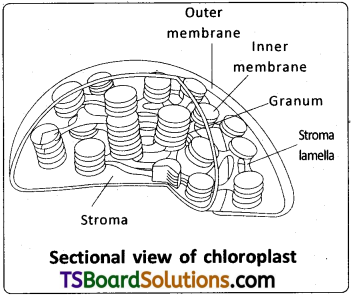
- Theylakoids enclose space called lumen
- Lumen contain pigments
Function:
- Stroma contains enzymes required for the synthesis of carbohydrate and proteins
- Chloroplasts are photosyathetic in funciton.
Mitochondria is also called the power houses of cell [Mar. ’15 – A.P.]
- Mitochondria are double membrane bourd structure.
- Mitochondria is sausage shae or chlirdroca;
- Eact mitochondria is a double membrane bound structure with outer and inner membrane.
Structure of Mitochondrion (Longitudinal Section)
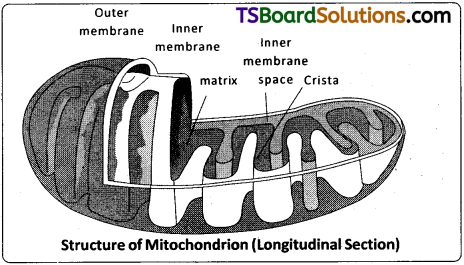
- Outer membrane is smooth. Inner membrane divide the lumen into outer compartment and inner compartment.
- Inner compartment is filled with matrix.
- Inner membrane forms a number of infoldings called cristae towards matrix.
Function:
- Mitochondria are the sites of aerobic respiration. They produce cellular energy in the form of ATP. hence they are called power houses of the cell.
- Matrix possess single circular DNA molecule, a few RNA molecules, ribosome (70S) required for protein synthesis.
Question 16.
What are the characteristics of a prokaryotic cell? [Mar. – 2018, May ’14]
Answer:
- Prokaryotic cell organisation is fundamentally similar.
- Prokaryote shows a wide variety of shapes and functions.
- All prokaryotic cells have cell wall surrounding the cell membrane.
- The fluid matrix filling the cell is the cytoplasm.
- There is no well defined nucleus.
- The genetic material is basically naked, that means not enveloped by a nuclear membrane.
- In addition to the genomic DNA (circular DNA), many bacteria have small circular DNA outside the genomic DNA. These smaller DNAs are called plasmids.
- No organelles like in eukaryotes are found except in ribosomes.
- A specialized differentiated form of cell membrane called mesosome is the characteristic of prokaryotic cell.
- It is essentially an infolding of the cell membrane.
![]()
Question 17.
Multicellular organisms have division of labour. Explain.
Answer:
- Multicellular organisms have numerous cells.
- The cells in multicellular organisms originate by the division of single celled zygote.
- Newly formed cells are specialised to perform specific function and a division of labour is established between these cells which co-exist in the body.
- Specialization of cells into tissues, organs and organ system is advantageous for multicellular organisms.
- Different functions are carried out by different groups of cells in an organism. This is known as division of labour.
Question 18.
Cell is the basic unit of life. Discuss in brief.
Answer:
- All life begins as a singe cell.
- Cell is a unit of structure and function. The unicellular organisms complete their entire life cycle as a single cell.
- In multicellular organisms cells are grouped into tissues, tissues into organs and organs into organ system. So cell is a basic unit of every small or complex organism.
- Each cell is made up of several organelles just like the one carried by different organ system. Thus all the life activities of an organism are present in miniature form in each and every cell of its body.
Question 19.
What are nuclear pores? State their function.
Answer:
At a number of places, the nuclear envelope is interrupted by minute pores which are formed by the fusion of its two membranes. These are called nuclear pores. A nuclear pore has complex structure.
Function :
The nuclear pores are the passage through which movement of RNA and protein molecules takes place in both directions between the nucleus and the cytoplasm.
Question 20.
Both lysosomes and vacuoles are endomembrane structures, yet they differ in terms of their functions. Comment.
Answer:
- Both lysosomes and vacuoles are endomembrane structures. Yet they differ in terms of their function because they contain different materials.
- The isolated lysosomal vesicles have been found to be very rich in almost all types of hydrolytic enzymes such as lipase, protease, carbohydrates. These enzymes are capable of digesting carbohydrate, proteins, lipids and nuclic acids.
- Vacuoles contain water sap, excretory products etc. In Amoeba, conctratile vacuole is important for excretion. In plants it plays an important role in osmoregulation.
- Thus though lysosomes and vacuoles are endomembrane, they are not similar in structure and function.
Question 21.
Briefly give the contribution of the following scientists in formulating the cell theory.
a) Rudolf Virchow
b) Schleiden and Schwann
Answer:
a) Rudolf Virchow :
First explained that cells divide and new cells are formed from pre-existing cells (Omnis cellula-e cellula). He modified the hypothesis of Schleiden and Schwann to give the cell theory. Cell theory is
- All living organisms are composed of cells and products of cells.
- All cells arise from pre-existing cells.
b) Schleiden and Schwann :
Schleiden, a German botanist, examined a large number of plants and observed that all plants are composed of different kinds of cells which form the tissues of the plant.
Schwann, a British zoologist, studied different types of animal cells and reported that cells had a thin outer layer which is today known as plasma membrane. He also concluded, based on his studies on plant tissue, that the presence of cell wall is a unique character of plant cells.
On the basis of this Schwann proposed the hyothesis that the bodies of animals and plants are composed of cells and products of cells.
Question 22.
Is extra genomic DNA present in prokaryotes and eukaryotes? If Yes, indicate their location in both the types of organisms.
Answer:
- Yes.
- In prokaryotes, in addition to the genomic DNA (single chromosome / circular DNA) many bacteria have small circular DNA outside the genomic DNA. These smaller DNAs are called plasmids.
- In Eukaryotes extra genomic DNA is present in mitochondria and chloroplast. Nucleolus has little amount of DNA.
![]()
Question 23.
Structure and function are correctable in living organisms. Can you justify this by taking plasma membrane as an example?
Answer:
- The structure of plasma membrane is similar in all organisms – ranging from unicellular prokaryotes to multicellular eukaryotes.
- Plasma membrane in all organisms is made of lipid bilayer. The polar (hydrophilic) heads of lipids are faced towards outside and hydrophilic tails are faced towards inside.
- The function of plasma membrane as semi permeable membrane is also similar in all living organisms.
- Neutral solutes and solvents like water move across the plasma membrane passively according to their concentration gradient.
- Polar molecules like ions move across the plasma membrane with the help of carrier proteins against their concentration gradiant. It is called active transprot.
Long Answer Type Questions
Question 1.
What structural and functional attributes must a cell have to be called a living cell?
Answer:
- The cell which have nucleus is called living cell. It was first observed by Robert Brown.
- The cell in which nucleus is absent is called dead cell.
- The nucleus controls and regulates the function of all the cell organelles. It is therefore, referred to as dynamic centre of the cell or master control of the cell or cell brain.
- Nucleus involves in heriditary.
- Nucleus plays an important role in reproduction in unicellular organisms.
- Cytoplasm is a semi fluid matrix. It occupies the volume of the cell.
- Cytoplasm is the main area of cellular activities in both the plant and animal cell.
- Various chemical reactions occur in it to keep the cell in the living state.
Cell organelles :
The cytoplasm shows several membrane bound structures called cell organelles which perform different functions and keep the cell in a dynamic state. Cell organelles are endoplasmic reticulum (ER), the Golgi complex, lysosomes, mitochondria, plastids, microhadies and vacuoles.
In prokaryotic cell membrane bound cell organelles are absent.
Ribosomes are considered as smallest cell organelle in the cells. Ribosomes are not bounded by a definite unit membrane within the cell; Ribosomes are called protein factories as they are important in protein synthesis.
Question 2.
Eukaryotic cells have organelles which may
a. Not be bound by a membrane
b. Bound by a single membrane
c. Bound by a double membrane
Group the various sub-cellular organelles into these three categories.
Answer:
Eukaryotic cells have organelles which may
a) Not be bound by a membrane are Ribosomes.
b) Bound by a single membrane are lysosomes, vacuoles, microbodies (Peroxysomes and Glyoxysomes)
c) Bound by a double membrane are Endoplasmic reticulu,, Golgi bodies, mitochondria, chloroplast, nucleus.
Question 3.
The genomic content of the nucleus is constant for a given species whereas the extra chromosomal DNA is found to be variable among the members of a population. Explain.
Answer:
- For a given species the genomic content of the nucleus is constant to maintain specificity and stability.
- Some bacteria have extra chromosomal DNA called plasmids.
- They can exist independently in the cytoplasm or may be integrated with the chromosome.
- The plasmids can render bacteria drug resistance, give them new metabolic pathways and make them pathogenic.
- The presence of DNA in the chloroplast and mitochondria helps in self duplication.
- Hence both chloroplast and mitochondria are called semi-autonomous organelles.
![]()
Question 4.
Justify the statement. “Mitochondria are power houses of the cell”.
Answer:
- Mitochondria occur in aii eukaryotic cells.
- Mitochondria possess double membrane envelope. Two unit membranes are separated by perimitochosidriaf space.
- Outer membrane is smooth. Inner membrane shows invaginations called cristae. The inner space is filled with fluid matrix.
- Matrix consists of 70S ribosomes, circular DNA and RNA. The matrix also comprises respiratory enzymes.
- Many stalked particles present on the surface of cristae are called F0- Fx particles.
- Krebs cycle of respiration occurs in the matrix and electron transport takes place in cristae.
- Mitochondria are concerned with cellular respiration. Food materials are oxidised and potential energy is converted into kinetic energy. It is stored in the form of adenosine triphosphate (ATP). So mitochondria are called power houses of the cell.
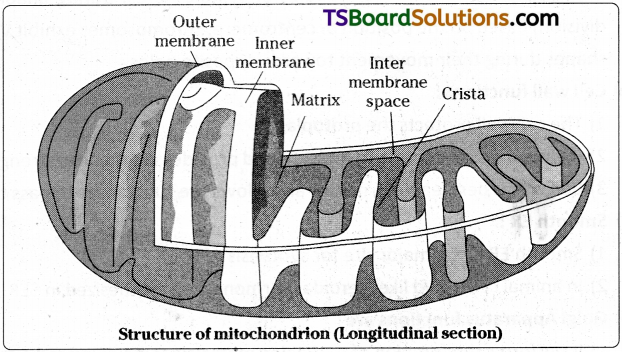
Question 5.
Is there a species specific or region specific type of plastids? How does one distinguish one from the other?
Answer:
Plastids bear specific pigments, thus imparting specific colours to the part of the plant which possesses them. Based on the type of pigments plastids can be classified into chloroplasts, chromoplasts and leucoplasts.
Chloroplasts :
They contain chlorophyll and carotenoid pigments which are responsible for photosynthesis.
Chromoplasts :
In chromoplasts fat soluble carotenoid pigments like carotene, xanthophylls and others are present. This gives the part of the plant a yellow, orange or red colour.
Leucoplasts :
They are colourless plastids of varied shapes and sizes with stored nutrients.
a) Amyloplasts store carbohydrates (starch) Eg. Potato
b) Elaioplasts store oils and fats
c) Aleutoplasts store proteins.
Question 6.
Write the functions of the following.
a. Centromere
b. Cell wall
c. Smooth ER
d. Golgi Apparatus
e. Centrioles
Answer:
a) Centromere :
Every chrpmosome has centromere. On the sides of centromere disc-shaped structures called kinetochores are present. These are the sites of implementation of the microtubules of spindle fibres. During anaphase (cell division) based on the position of centromere, chromosomes exhibit V, L, J and I shapes during their movement towards opposite poles.
b) Cell wall functions :
- The cell wall protects the protoplast.
- It gives a definite shape to the cejls and provides mechanical strength.
- Cell wall is permeable in nature and allows the substances to pass through.
c) Smooth ER:
- Smooth ER is the major site for synthesis of lipid.
- In animal cells, lipid like steroidal hormones are synthesized in SER.
d) Golgi Apparatus functions are:
- It performs the function of packaging materials to be delivered either to the intra-cellular targets or secreted outside the cell.
- Number of proteins synthesised by ribosomes are modified in the cisternal of golgi apparatus before they are released.
- It is an important site of formation of glycoproteins and glycolipids.
- In plants Golgi complex involves in the synthesis of cell wall materials.
- It plays an important role in “cell plate formation” during cell division.
e) Centriole function :
- It forms the basal body of cilia or flagella.
- It forms spindle fibres that give rise to spindle apparatus during cell division in animal cells.
Question 7.
Are the different types of plastids interchangeable? If yes, give examples where they are getting converted from one type to another.
Answer:
- Yes, plastids are interchangeable.
- During various stages of growth, the plastids change their colour from one type to other.
- For instance, in potato when tubers are exposed to air, leucoplasts convert into chloroplasts.
- In tomato and chillies, the Ovaries contain leucoplasts, which change into chloroplasts after fertilisation and in ripe condition, the chloroplasts are transformed into chromoplasts.
- Chloroplasts can be seen in the petals which are green initially but later become coloured.
![]()
Question 8.
Describe the structure of the following with the help of labelled diagrams.
i) Nucleus
ii) Centrosome
Answer:
i) Nucleus:
- Nucleus was first described by Robert Brown.
- The nucleus consists of highly extended and elaborate nucleo protein fibres called chromatin, nuclear matrix and spherical bodies called nucleoli.
- The nuclear envelope, consists of two membranes with a space between called the perinuclear space.
- Outer membrane is continuous with the endoplasmic reticulum and also bears ribosomes on it.
- At a number of places the nuclear envelope is interrupted by minute pores, which are formed by the fusion of its two membranes.
- Nuclear pore establishes a contact between nucleoplasm and cytoplasm.
- The nuclear matrix or the nucleoplasm contains nucleolus and chromatin.
- Nucleoli are spherical structures present in the nucleoplasm.
- The content of nucleolus is continuous with the rest of the nucleoplasm as it is not membrane bound structure.
- Nucleolus is a site for active ribosomal RNA synthesis. Numerous nucleoli carry out protein synthesis.
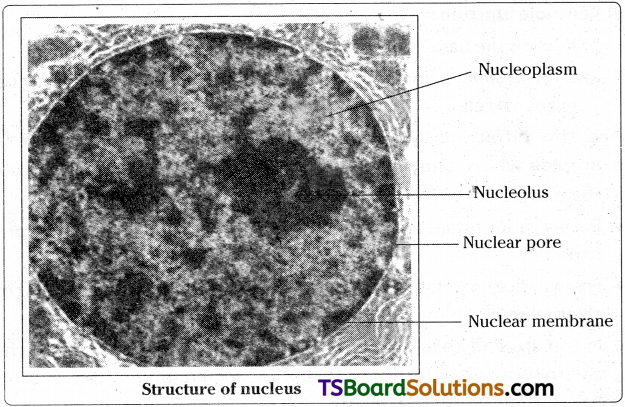
ii) Centrosome :
- Centrosome is an organelle usually containing two cylindrical structures called centrioles.
- They are surrounded by amorphous pericentricular materials.
- Both the centrioles in the centrosome lie perpendicular to each other in which each has an organisation like cartwheel.
- They are made up of nine evenly spaced peripheral fibrils of tubulin.
- Each of the peripheral fibril is a triplet.
- The adjacent triplet are also linked.
- The hub of centriole is connected with tubules of the peripheral triplets by radial spokes made of protein.
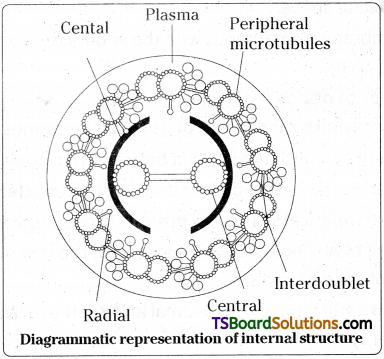
Question 9.
What is a centromere? How does the position of centromere form the basis of classification of chromosomes? Support your answer with a diagram showing the position of centromere on different types of chromosomes.
Answer:
- The region of the chromosome where two chromatids are held together at a point along their length is called primary contriction or centromere.
- Two disc like structures present on either side of the centromere are known as kinetochores.
- On the basis of centromere position monocentric chromosomes are 4 types :
1. Metacentric :
Centromere is present in the middle point of the chromosome. Both arms are equal in length. Chromosome appears in V shape during anaphase.
2. Submetacentric :
Centromere is slightly away from the middle point of chromosome and both arms are unequal in length. Chromosome appears in ‘L’ shape during anaphase.
3. Acrocentric :
Centromere is present towards one side. One arm is very long and the other arm is very short. Chromosome appears in ‘J’ shape during anaphase.
4. Telocentric :
Centromere is present at the end of the arm. Only one arm is present. Chromosome appears in T shape during anaphase.
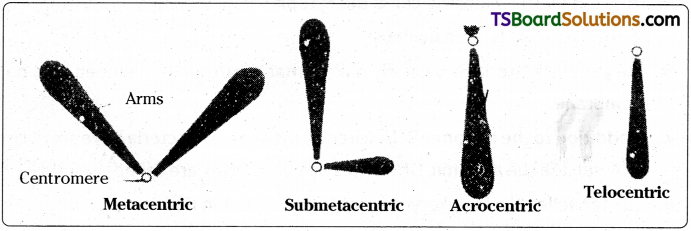
Intext Question Answers
Question 1.
What is a mesosome in a prokaryotic cell? Mention the functions that it performs.
Answer:
- Plasma membrane is made up of lipids and protein.
- Mesosome is a special membranous structure which is formed by the extensions of plasma membrane into the cell.
- These extensions are in the form of vesicles, tubules and lamellae.
- They help in cell wall formation, DNA replication and its distribution to daughter cells.
- They also help in respiration, secretion processes to increase the surface area of plasma membrane and enzymatic content.
![]()
Question 2.
How do neutral solutes move across the plasma membrane? Can the polar molecules also move across it in the same way? If not, then how are these transported across the membrane?
Answer:
- Neutral solute may move across the membrane by the process of simple diffusion along the concentration gradient i.e., from higher concentration to lower concentration.
- Polar molecules require carrier proteins of the membrane to facilitate their transport across the membrane.
In active transport, a few ions or molecules (eg., Na+/ K+ pump) are transported across the membrane by carrier proteins against their concentration gradient (i.e. from lower to higher concentration) with the utilization of ATP.
Question 3.
What are the characteristics of a prokaryotic cell?
Answer:
- Prokaryotic cell organisation is fundamentally similar.
- Prokaryote shows a wide variety of shapes and functions.
- All prokaryotic cells have cell wall surrounding the cell membrane.
- The fluid matrix filling the cell is the cytoplasm.
- There is no well defined nucleus.
- The genetic material is basically naked, that means not enveloped by a nuclear membrane.
- In addition to the genomic DNA (circular DNA) many bacteria have small circular DNA outside the genomic DNA. These smaller DNAs are called plasmids.
- No organelles like in eukaryotes are found except in ribosomes.
- A specialized differentiated form of cell membrane called mesosome is the characteristic of prokaryotic cell.
- It is essentially an infolding of the cell membrane.
Question 4.
Multicellular organisms have division of labour. Explain.
Answer:
- Multicellular organisms have numerous cells.
- The cells in multicellular organisms originate by the division of single celled zygote.
- Newly formed cells are specialised to perform specific function and a division of labour is established between these cells which co-exist in the body.
- Specialization of cells into tissues, organs and organ system is advantageous for multicellular organisms.
- Different functions are carried out by different groups of cells in an organism. This is known as division of labour.
Question 5.
Cell is the basic unit of life. Discuss in brief.
Answer:
- Cell is a unit of structure and function. The unicellular organisms complete their entire life cycle as a single cell.
- In multicellular organisms cells are grouped into tissues, tissues into organs and organs into organ system. So cell is a basic unit of every small or complex organism.
- Each cell is made up of several organelles just like the one carried by different organ system. Thus all the life activities of an organism are present in miniature form in each and every cell of its body.
Question 6.
What are nuclear pores ? State their function.
Answer:
At a number of places the nuclear envelope is interrupted by minute pores which are formed by the fusion of its two membranes. These are called nuclear pores. A nuclear pore has complex structure.
Function :
The nuclear pores are the passage through which movement of RNA and protein molecules takes place in both directions between the nucleus and the cytoplasm.
Question 7.
Both lysosomes and vacuoles are endomembrane structures, yet they differ in terms of their functions. Comment.
Answer:
- Both lysosomes and vacuoles are endomembrane structures. Yet they differ in terms of their function because they contain different materials.
- The isolated lysosomal vesicles have been found to be very rich in almost all types of hydrolytic enzymes such as lipase, protease, carbohydrates. These enzymes are capable of digesting carbohydrate, protein^, lipids and nuclic acids.
- Vacuoles contain water sap, excretory products etc. In Amoeba, conctratile vacuole is important for excretion. In plants it plays an important role in osmoregulation,
- Thus though lysosomes and vacuoles are endomembrane, they are not similar in structure and function.
![]()
Question 8.
What is a centromere? How does the position of centromere form the basis of classification of chromosomes? Support your answer with a diagram showing the position of centromere on different types of chromosomes.
Answer:
1) On the basis of centromere position monocentric chromosomes are 4 types :
1. Metacentric :
Centromere is present in the middle point of the chromosome. Both arms are equal in length. Chromosome appears in V shape during anaphase.
2. Submetacentric :
Centromere is slightly away from the middle point of the chromosome and both arms are unequal in length. Chromosome appears in ‘L’ shape during anaphase.
3. Acrocentric :
Centromere is present towards one side. One arm is very long and the other arm is very short. Chromosome appears in ‘J’ shape during anaphase.
4. Telocentric :
Centromere is present at the end of the arm. Only one arm is present. Chromosome appears in ‘I’ shape during anaphase.